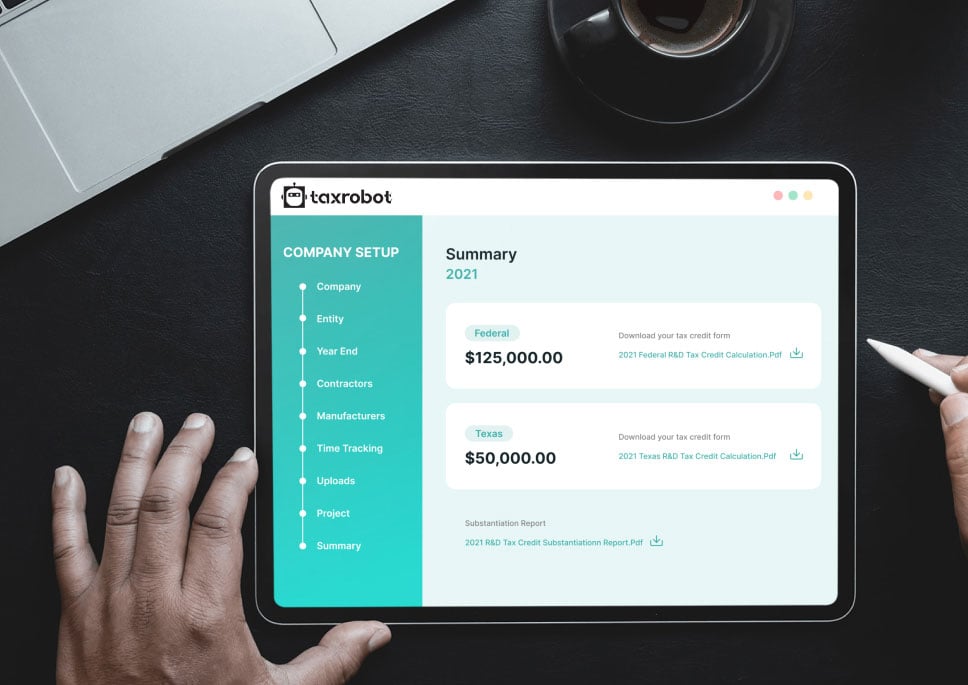West Virginia R&D Tax Credit
Uncover a new world of Research and Development (R&D) tax credits with TaxRobot. Our ground-breaking AI-powered software is designed to streamline your R&D tax credit
claim process, ensuring accuracy and maximum returns for businesses throughout West Virginia.
Maximize your State Credits today!
Put the R&D tax credit process on autopilot.
Trusted By:








West Virginia R&D Tax Credits
Discover your eligibility for West Virginia R&D tax credits and supercharge your enterprise.
Experience the Power of AI with TaxRobot's R&D Tax Software
TaxRobot utilizes the latest artificial intelligence technology to simplify the complex realm of R&D tax credits. Seamlessly integrating with your existing accounting and payroll systems, our software accurately identifies qualifying activities and expenses in line with current IRS guidelines.
Here’s how it works:
- Input Your Information: Provide necessary details about your business and its R&D activities.
- Connect Your Systems: Let TaxRobot go to work identifying qualifying activities and expenditures.
- Claim Your Credits: TaxRobot calculates your potential R&D tax credit. It will even give you a comprehensive report ready for submission to the IRS.
Why Choose TaxRobot for Your West Virginia Business?
R&D Tax Credit Experts
Our team consists of friendly and experienced tax professionals who possess an in-depth understanding of R&D tax credits. We constantly stay abreast of the latest tax laws and IRS guidelines, ensuring that you receive the utmost benefits. Trust us to maximize your returns!
Audit Support
We’re not just here to help you claim your R&D tax credits. We’re with you every step of the way. If your claim gets audited, our team of experts will provide unwavering support, ensuring you’re fully prepared and equipped with all the necessary documentation. Your success is our priority!
Value-Based Pricing
Experience the power of TaxRobot, where you pay for the value you get. Our pricing model is crafted to be affordable and flexible, tailored for businesses of all sizes. Discover a more innovative way to handle your taxes!
Bigger Refunds
Our innovative AI-powered software is meticulously crafted to uncover every eligible activity and expense, guaranteeing you the ultimate refund experience.
Save Time
Claiming R&D tax credits can sometimes be a daunting task, taking up precious time and requiring intricate knowledge. But fear not! TaxRobot is here to simplify the process, freeing up valuable time for you to reinvest in your business and fuel your growth. Let us handle the complexities while you focus on what you do best!
Superior Documentation
TaxRobot is your trusty sidekick, tirelessly compiling and organizing all the necessary documentation for your R&D tax credit claims. Say goodbye to audit worries and hello to a streamlined claiming process. Let us handle the paperwork while you focus on innovation!
Understanding the R&D Tax Credit
The R&D tax credit is a major government incentive designed to stimulate innovation and economic growth across various sectors. It rewards U.S. companies that increase their spending on research and development within the country.
For businesses in West Virginia, especially those in fast-growing sectors like energy, manufacturing, and technology, these credits can tremendously reduce your tax liability and increase your cash flow.
Stay Ahead with TaxRobot in West Virginia
As West Virginia continues to innovate in areas like energy and manufacturing, the opportunities for claiming R&D tax credits are expanding. TaxRobot stays updated with these changes, ensuring your business gets all the potential credits. Contact us today to get started claiming your R&D credits.
Begin Your Journey with TaxRobot in West Virginia Today
Navigating the complexities of R&D tax credits can be manageable. With TaxRobot, you have a partner committed to maximizing your R&D tax credits while providing top-notch customer service.
Experience the future of R&D tax credits today. Contact us at TaxRobot and let our AI-driven software and team of experts guide you through the process.
Take a sneak peak

- Limited Time Offer
- Simple Onboarding
- Easy to Use
R&D Tax Credits FAQs
The four-part test as outlined in the Internal Revenue Code is used to determine qualified R&D activity.
The Four-Part Test
1). New Or Improved Business Component
Creation of a new product, process, formula, invention, software, or technique; or improving the performance, functionality, quality, or reliability of existing business component.
- Construction of new buildings or renovation of existing buildings
- Invention of a software application
- Manufacturing of a new product or the improvement of the production process for an existing product
- Creation of design documentation
2). Technological In Nature
The activity fundamentally relies on principles of the physical or biological sciences, engineering, or computer science. A taxpayer does not need to obtain information that exceeds, expands or refines the common knowledge of skilled professionals in a particular field.
- Physics (relationship between mass, density and volume; loading as the
result of gravitational attraction) - Engineering (mechanical, electrical, civil, chemical)
- Computer science (theory of computation and design of computational systems)
3). Elimination Of Uncertainty
Uncertainty exists if the information available to the taxpayer does not establish the capability or method for developing or improving the business component, or the appropriate design of the business component.
- The capability of a manufacturer to create a part within the specified tolerances
- The appropriate method of overcoming unsuitable soil conditions during construction
- The appropriate software design to meet quality and volatility requirements
4). Process Of Experimentation
A process designed to evaluate one or more alternatives to achieve a result where the capability or method of achieving that result, or the appropriate design of that result, is uncertain as of the beginning of the taxpayer’s research activities.
- Systematic process of trial and error
- Evaluating alternative means and methods
- Computer modeling or simulation Prototyping Testing
The R&D tax credit is one of the most misunderstood tax incentives available. Considering the myriad of industries and activities that legally qualify for the credit, the term “research and development” is a misnomer. Additionally, the R&D tax credit requires specialized knowledge and technology to identify and calculate the incentive properly.
Companies of various industries are unaware that they are eligible to claim the R&D tax credit. Under the Internal Revenue Code’s definition of R&D, many common activities qualify. You can get tax benefits for industries including software, technology, architecture, engineering, construction, manufacturing, and more.
The R&D tax credit can be claimed for all open tax years. Generally, open tax years include the prior three tax years due to the statute of limitations period. In certain circumstances, the law allows businesses to claim the R&D tax credit for an extended period of time. It is common for companies to amend previous tax years to claim this benefit and reduce the maximum amount of tax liability.
Partnerships and S corporations must file this form to claim the credit. The credit will flow from the Form 6765, to the Schedule K-1, to the Form 3800 on the individual’s tax return. For individuals receiving this credit that have ownership interest in a partnership or S corporation, Form 6765 is not required on the individual return.
Individuals claiming this credit can report the credit directly on Form 3800, General Business Credit if their only source for the credit is a partnership, S corporation, estate, or trust. Otherwise, Form 6765 must be filed with the individual’s tax return (e.g. sole proprietorship).
For tax years prior to 2016, the credit can be used to reduce the taxpayer’s regular tax liability down to the tentative minimum tax. The credit cannot be used to offset alternative minimum tax. Beginning in tax year 2016, eligible small businesses have expanded utilization for the credit. For these eligible small businesses, the regular tax liability can offset alternative minimum tax using the “25/25” rule.
What our customers have to say
I highly recommend TaxRobot to anyone considering an R&D Tax Credit software to complete their analysis.

We decided to switch to TaxRobot… Best decision we’ve ever made. More affordable, and less complicated.

I couldn’t believe how easy it was! In under an hour, we saved enough money to hire a new employee.
